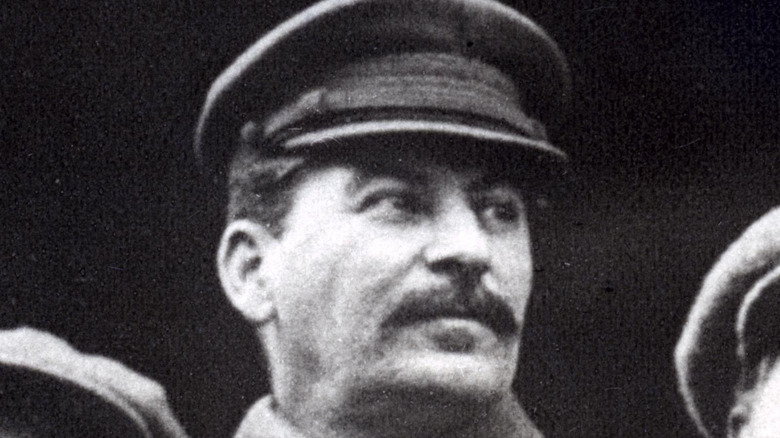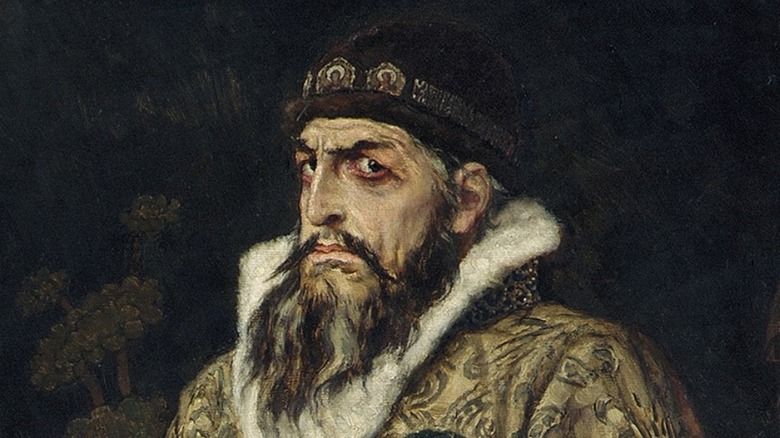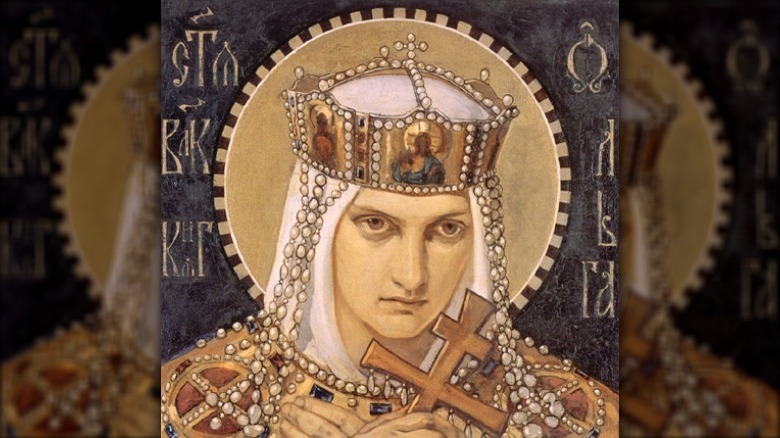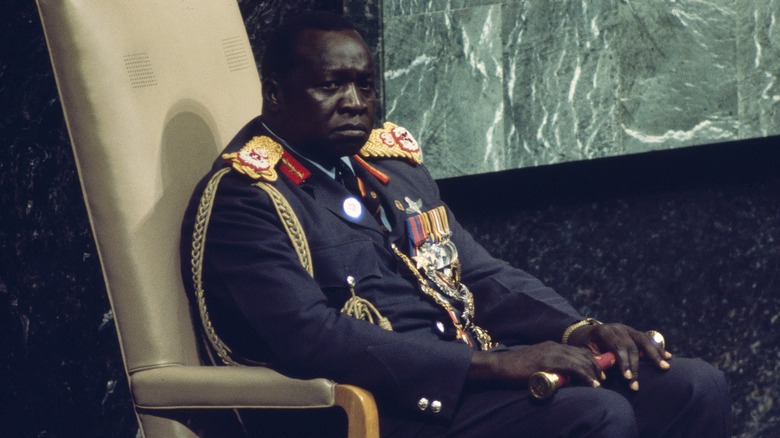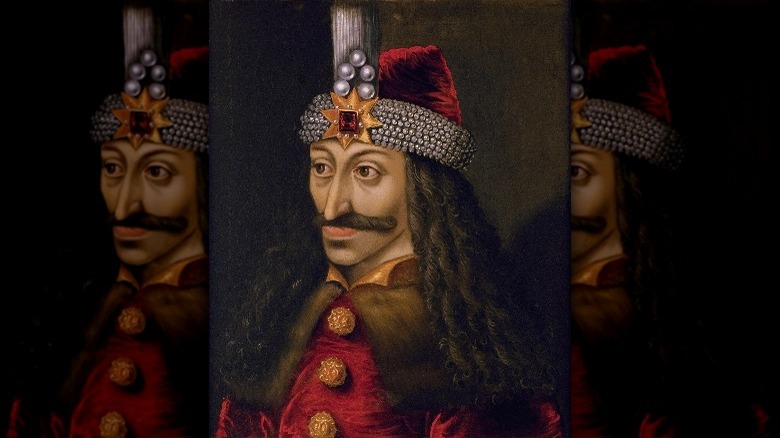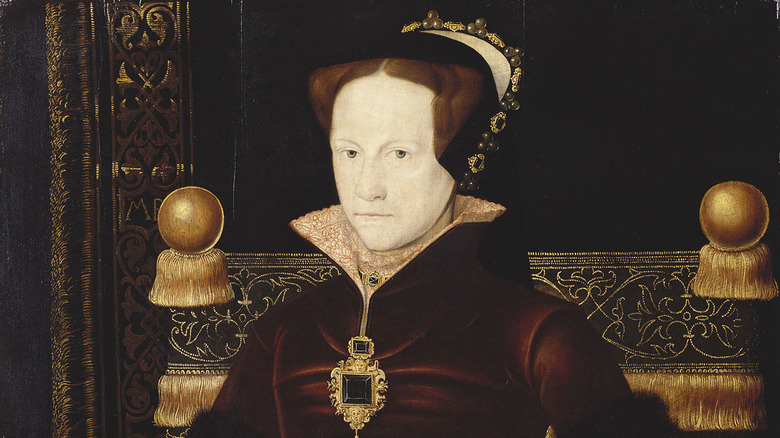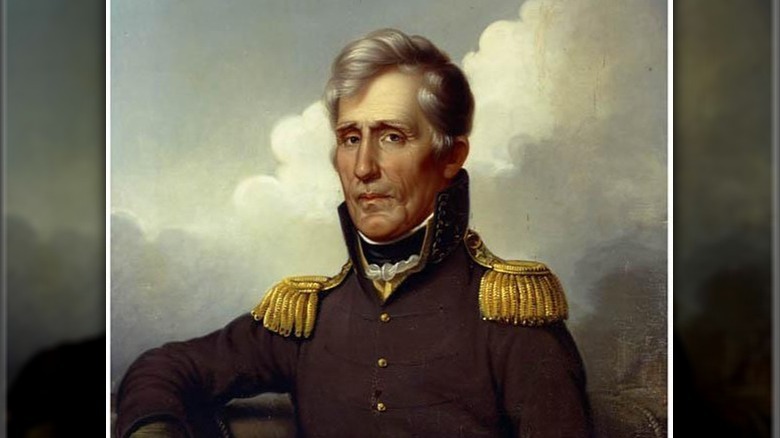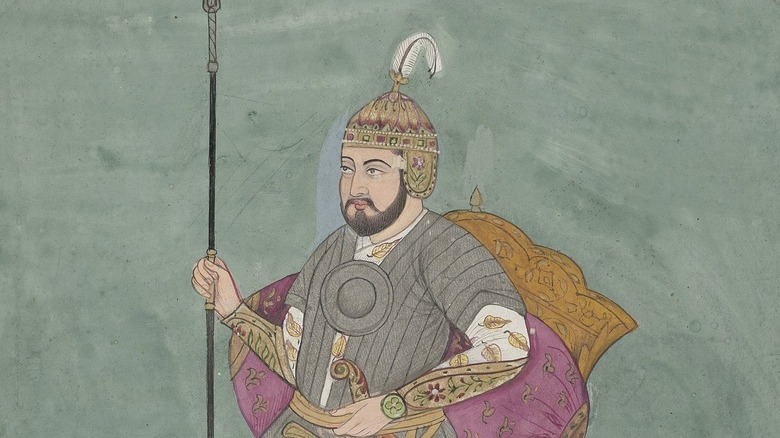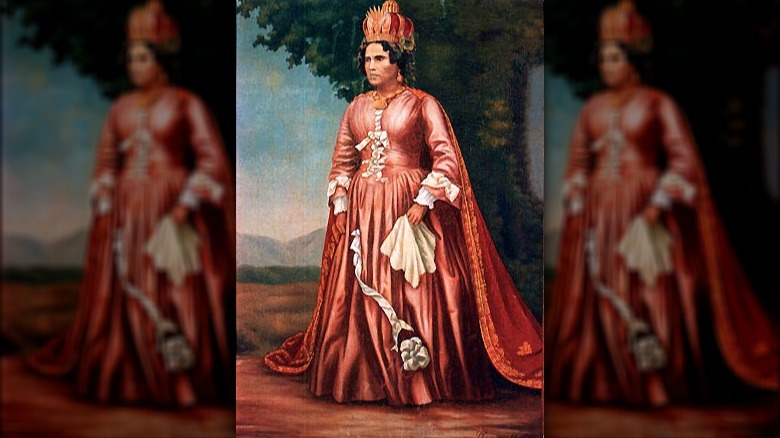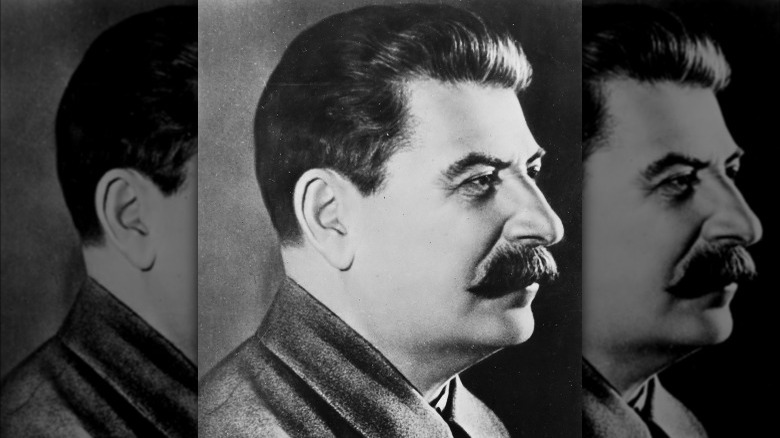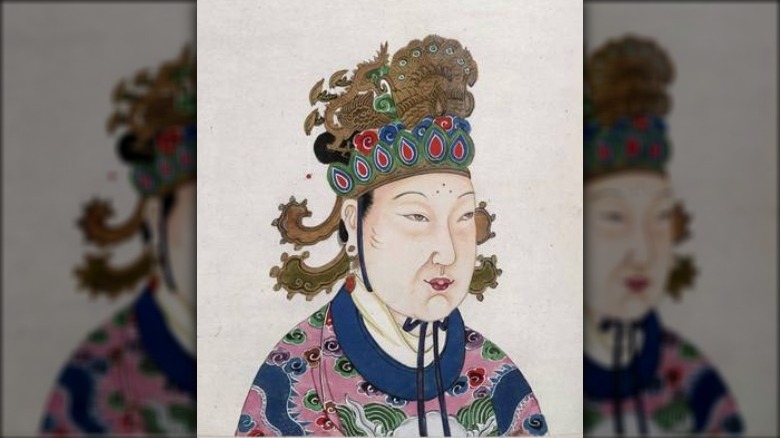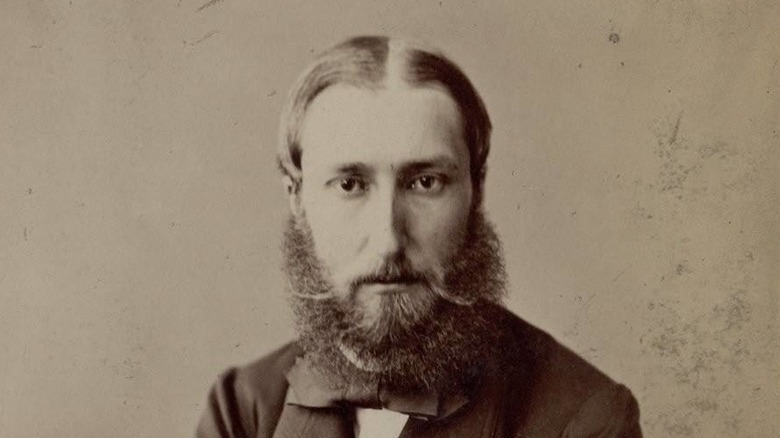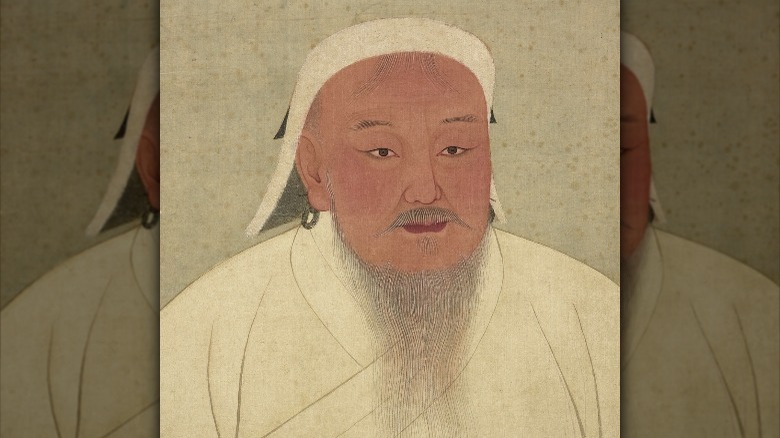The Most Cold-Blooded Rulers In History
Getting ahead as a ruler can be pretty hard. Whether you're considering the kings and queens of the past or the world leaders of today, there are certain factors that are nearly always in play. Everyone around the ruler wants power, it seems, and are often willing to stoop to some serious lows and backhanded tactics to get it. Though some people reacted to that by taking an enlightened path, the reality of kingship and government throughout the ages has often meant the opposite. For many rulers, maintaining power and keeping their head attached to their neck meant getting pretty ruthless themselves.
Sometimes, that meant sacking entire cities and devastating the populations within, regardless of whether or not that included innocent civilians. At other times, it required a clear-eyed evaluation of one's enemies and an even more direct method of getting rid of them. Of course, as some of these rulers will painfully demonstrate, that sort of thing could also stem from paranoia and poor judgment as much as anything else. Either way, these are some of the biggest, baddest, and absolute most cold-blooded rulers in all of human history.
Ivan the Terrible
With a name like "Ivan the Terrible," it may seem obvious that Ivan was pretty harsh. His story reveals dramatic, bloody incidents that were reportedly spurred both by hot-blooded, rash reactions, and some far more chilling ones, too.
Ivan, who lived and died in the 16th century, was the first tsar of Russia. Per ThoughtCo, "Russia" before then was actually an assemblage of loosely allied states. And, yes, you can certainly make the argument that the "terrible" in Ivan's eventual moniker was more like "formidable" — but try and tell that to his family and enemies. After leaving and then returning to the throne in the 1560s, he started a campaign of executing nobles (known in Russia as boyars) who weren't sufficiently loyal. Ivan's personal guards got the boyars' now-vacant landholdings and proceeded to terrorize the peasants.
At least the peasants were sometimes able to move on, unlike Ivan's wives. They rotated through royal favor and exile, alongside a series of mistresses. But his most cold-blooded action of all was surely the vengeance visited upon Novgorod in 1570. Fearing that everyone would defect to Lithuania, Ivan ordered that everyone in the city — yes, everyone, including children — be tortured and executed. Alas, as History notes, such atrocities were pretty typical of his style of conquest.
Olga of Kiev
For someone who's a saint in the Eastern Orthodox Church, the stories told about Olga of Kiev are pretty hair-raising. Of course, given that she died way back in 969, it's possible that the tales of her bloody vengeance are exaggerated.
According to ThoughtCo, Olga's backstory is pretty scanty, but we do know that she was married to Prince Igor I of Kiev in the early 10th century. When Igor was killed around 945, Olga became Kiev's regent. A single woman in power was apparently both intimidating and attractive, and so the marriage proposals started rolling in. One of the applicants was, surprisingly enough, a man who was connected to Igor's killers: the Drevlian prince Mal.
Chronicles of the time claim that Olga first pretended to play nice with the Drevlians. But when Prince Mal's emissaries came along to negotiate the terms of the marriage, she tricked them into riding into town on a boat. Weird, sure, but then Olga's representatives overturned the boat into a big ditch and buried the men alive. Another group of Drevlians was later burned to death in a bathhouse. You'd think the third party would be more cautious, but, according to WBUR, they were treated to a raucous party, and then, when every man was good and drunk, Olga and her servants reportedly cut their insensible throats. She eventually goes to war with them, burns down their city, kills or enslaves the occupants, and then collects an expensive tribute.
Idi Amin
During the 1970s, Uganda was experiencing some serious upheaval. According to History, it started almost right away in 1971, when General Idi Amin took it upon himself to overthrow the nation's government and declare himself president. Those were already after some pretty cutthroat moves on Amin's part, including an incident in the 1960s where Milton Obote, the previous prime minister, had ordered General Amin to dethrone a troublesome nearby king.
But things got truly awful after Amin quasi-officially took power. Tribal members who had sided with Obote in the past were subjected to horrifying killings, while anyone else who even seemed capable of opposing Amin was put in danger, too. All told, Amin's rampant paranoia resulted in the deaths of a staggering 300,000 people over the course of just eight years.
Amin's ruthless tactics weren't just limited to cold-blooded murder of his own people, either. Just a year after becoming president, Amin forced Asian immigrants out of the country, leading to a worker shortage and economic collapse that only made Uganda's situation worse. Unsurprisingly, Amin was deeply unpopular and, after antagonizing nearby Tanzania, was ousted in 1979. He fled the country and lived until his death in 2003, says the New York Times, never facing prosecution for his crimes.
Vlad the Impaler
Being a medieval ruler in Europe surely wasn't an easy job. Things like international conventions and diplomatic talks could be few and far between, and it often seemed as if treaties and allegiances could be broken at a whim. But, even in this oftentimes unstable world, Vlad III stood out as a shocking figure.
Of course, you may know him by a different name. According to Britannica, this 15th-century Walachian ruler (in what's now Romania) also went by Vlad III Dracula or Vlad Țepeș. And, yes, Irish writer Bram Stoker may well have drawn upon this bloody man's name for his own famous literary character: Dracula.
But what made Vlad so shocking? In his years-long struggle with fellow nobles and also the Ottoman Empire, Vlad developed a taste for impaling. If captured, his enemies might expect a slow, agonizing death while speared on tall wooden spikes. One 1462 battle reportedly resulted in thousands of such victims, left behind to shock and turn back Ottoman soldiers. Chronicles of the time even claimed that Vlad calmly dined amongst a hideous forest of his victims (via Medievalists.net), though, again, we can't be certain whether this particular thing is the historic equivalent of fake news or something that actually happened.
Mary I
England's Mary I is a deeply complicated ruler. The first daughter of the equally thorny Henry VIII, she was once declared illegitimate after her father dumped her mother for Anne Boleyn. Yet she also made her way to the throne as the first independently ruling queen of her nation (via Biography).
Her life up to then was surely full of quite a few cold-blooded calculations (how could you survive in the cutthroat court of Henry VIII without them?), but things really picked up when she gained the throne. You see, as History Extra points out, Mary was a Catholic. Her father famously broke away from the church to marry Anne. So, his daughter was determined to stamp out Protestantism and bring the old way of Christianity back to England, and in oftentimes brutal fashion.
She earned the "Bloody Mary" nickname after she had nearly 300 religious dissenters killed, many of whom met their ends being burned at the stake. To be fair, she wasn't the only European ruler to employ this brutal tactic in the name of religion. She also deserves some credit for navigating the incredibly sexist world of Tudor England as a single and powerful woman. Yet her violent persecution of Protestants remains an inescapable facet of her reign.
Andrew Jackson
While a number of leaders in the United States of America could be pinned for especially ruthless tactics, few fit the bill quite as awfully as President Andrew Jackson. And though it may be uncomfortable for fans of U.S. history to call a president "cold-blooded," a look at Jackson's history of oftentimes violent, racist behavior makes this incredibly hard to deny.
For one, Jackson was very, very pro-slavery. According to History, he built his fortune upon the backs of enslaved people and also treated them brutally, sometimes with humiliating public beatings. As president, he even specifically blocked the distribution of anti-slavery literature in the South, pushed back against laws that would have banned slavery in new territorties, and even said that abolitionists should be killed for their work.
Then, there are the atrocities he committed against Native Americans. Vox reports that Jackson advocated for the removal of native people from their tribal lands, in part because he wanted said land freed up for plantations worked by slaves. Agreements were broken, payments to tribes were stopped, and local governments stripped away the rights of tribal members. And when he had Cherokee people forcibly removed from their lands, anywhere from 4,000 to 8,000 died as a result. That's not including the many more native people who died from Jackson's other racist policies.
Timur
Timur, also known to history as Tamerlane. Born in 14th-century Transoxiana (now modern-day Uzbekistan), Timur actually first lived a fairly sedentary life compared to his Mongolian ancestors, says ThoughtCo. His father and uncle were leaders of their Barlas tribe, but were eventually ousted by outside forces in favor of Timur. Yet the newbie wasn't nearly as much of a pushover as they had hoped. He was then quickly thrown out of power, but found his way back after a period of acting as a brigand and freelance soldier.
Ultimately, Timur got back into the empire-building game, but it didn't come without bloodshed. "Titans of History" notes that his tactics were intentionally awful, meant to psychologically defeat many opponents before they were foolish enough to try anything. This included a rumor mill of all the awful things he had supposedly done, but also reportedly incorporated real atrocities like murdering thousands of civilians. In Damascus, he was said to have burned down an entire mosque with people inside and, in Persia, levelled entire cities to the ground for opposing him. But he may be most luridly remembered for the story that, upon his orders, many of those killed were assembled into gory towers built of their skulls (via Britannica).
Ranavalona I
Ranavalona's story is a complicated one. For many, she's remembered as a particularly vicious ruler who imposed her will upon the kingdom of Madagascar with violent aplomb. And yet she was also a key resistor to colonial rule that threatened to take over her homeland. It could well be that, as Rejected Princesses notes, many of the more colorful tales of her cruelty were fabricated by sore loser colonialists.
But she did have to make bold and sometimes harsh moves. According to Encyclopedia.com, Ranavalona — who was initially known as Ramavo — first took power after her husband, Radama I, died by suicide in 1828. It wasn't easy, though, given that Ramavo was technically out of the line of succession and seized control by killing off quite a few of Radama's more troublesome relatives. It was, at least, technically bloodless, since spilling royal blood was a big offense at the time. Instead, people like the heir and the queen mother were strangled or denied food until they starved to death. At that point, Ramavo became queen and renamed herself Ranavalona.
Unlike her deceased husband, Ranavalona was unfriendly to European powers sniffing around her territory, though she did work with a French castaway, Jean Laborde, who became her weapons manufacturer. She also brought slavery back into Malagasy society and forbade the construction of any permanent roads (given that they would provide an easy in for European forces to invade).
Joseph Stalin
While some of the more distant rulers accused of heinous acts might be able to squeak by under claims of poor record keeping, Joseph Stalin has no such excuse. As one of the most notorious world leaders of the 20th century, his exploits were all pretty well documented.
Per the BBC, Stalin's early years were a mix of childhood abuse, socialist idealism, and occasional bank robbery. The Russian Revolution of 1917 turned him into a communist hero and Lenin's buddy. When Lenin died in 1924, Stalin was there to name himself dictator of the Soviet Union. All fairly ruthless so far, but Stalin had only just gotten going. Eventually, his idea of collectivizing agriculture led to widespread famine as the system started going, most notably the great famine of 1932-1933, which killed an estimated 5 million people (via The Atlantic). Those who attempted to exploit the system or hide grain officially belonging to the state faced potential execution.
But some of Stalin's most cold-blooded tactics included the establishment of harsh prison camps, known collectively as the gulag, says George Mason University. Many of the people caught up in his Great Purge of the 1930s were sent there, as anyone who represented a potential threat to Stalin's control faced either harsh conditions in the gulag or outright execution. According to History, an estimated 750,000 people were killed in the Great Purge alone, while many more were terrorized by the widespread climate of fear.
Wu Zetian
If you read the stories written about Empress Wu Zetian, you might think she was especially bloodthirsty. Of course, as Smithsonian Magazine notes, many of the worst tales may in fact be rooted in sexism levied at a powerful empress who ruled for over 50 years.
Leaving aside the more colorful (and probably less likely to be true) episodes of her life, though, it's clear that Wu had to be at least somewhat cold-blooded to survive for as long as she did. According to the World History Encyclopedia, she started off as the highly educated 14-year-old concubine of Emperor Taizong. Her charm and intellect jettisoned her from laundry duty and into the confidence of Taizong. What's more, she apparently caught the eye of Li Zhi, Taizong's son and the next emperor. After his father died, Li Zhi became Emperor Gaozong and, in an unusual twist, pulled Wu out of her retirement (the standard fate for a dead emperor's concubines) and into his own household.
Eventually, Wu had a daughter who died shortly after birth. She accused Gaozong's wife and another concubine of using witchcraft against the infant, got them exiled, and then became Gaozong's new wife. She was ultimately the power behind the throne and, when her husband died in 683, Wu assumed the same would happen with her sons. But the two men pushed back, so she had them exiled and dethroned before finally taking the reins of power outright.
Leopold II of Belgium
Though he created the "Congo Free State," Leopold II of Belgium's actions in Africa show he was invested in anything but freedom. It certainly started off poorly, given that Leopold's forces aggressively took the African territory in early 1885, making it the king's personal landholding (via National Geographic). Leopold himself "owned" the territory, rather than using a colonial model to exploit the people and resources there — but exploited they were, all the same.
Said exploitation included forced labor as Congolese people were made to harvest resources like ivory. If they resisted the king's will, they were brutally punished with tortuous methods like chopping off body parts. According to the BBC, that included the mutilation and murder even of children. Other young Congolese were sent away to train as child soldiers. Malnutrition and disease killed many more, with some estimating that 10 million people died as a result of Leopold's policies.
The king even had people shipped in from the Congo to stand around in a "human zoo" installed at his palace. Though some of his descendants weakly defend the king by saying that he never personally set foot in the colony, the bare fact remains that he very clearly profited off the suffering there, all while claiming he was on a mission to "civilize" the Congo. Eventually, it got so bad that even other colony-happy European rulers were horrified and Leopold's own parliament forced him to give up the lands.
Genghis Khan
No collection of cold-blooded rulers would be complete without a mention of Genghis Khan. Now, like so many world leaders, especially those with a few centuries between their exploits and now, Genghis has a complicated reputation. He was, as History Extra notes, a clearly gifted military leader whose territories eventually encompassed some 12 million square miles. What's more, the Mongol Empire did have some pretty progressive policies that encouraged women's rights, promoted cultural exchange, and eschewed torture (most of the time).
Yet, to get his empire to the heights that it reached, Genghis did not use gentle or easygoing tactics. His Mongol army did invade and make war, after all, sacking cities and murdering people along the way. According to "The Geography of Genocide," different cities saw hundreds of thousands or even millions of people killed during these campaigns. The 1.7 million people of Nishapur — in what's now modern-day Iran — were culled after someone from the city managed to kill Genghis' son-in-law. In one story, it's claimed that Genghis had one governor killed by pouring blazingly hot molten silver into the man's eyes and ears.
While some stories and numbers are difficult to verify, the impact of the Khan's movements are more stark. Discover argues that Mongol forces decimated some cultures, like that of the Xi Xia people. Meanwhile, the genetic legacy of the Khan indicates that he — perhaps along with his sons — weren't above assaulting women taken as captives.
